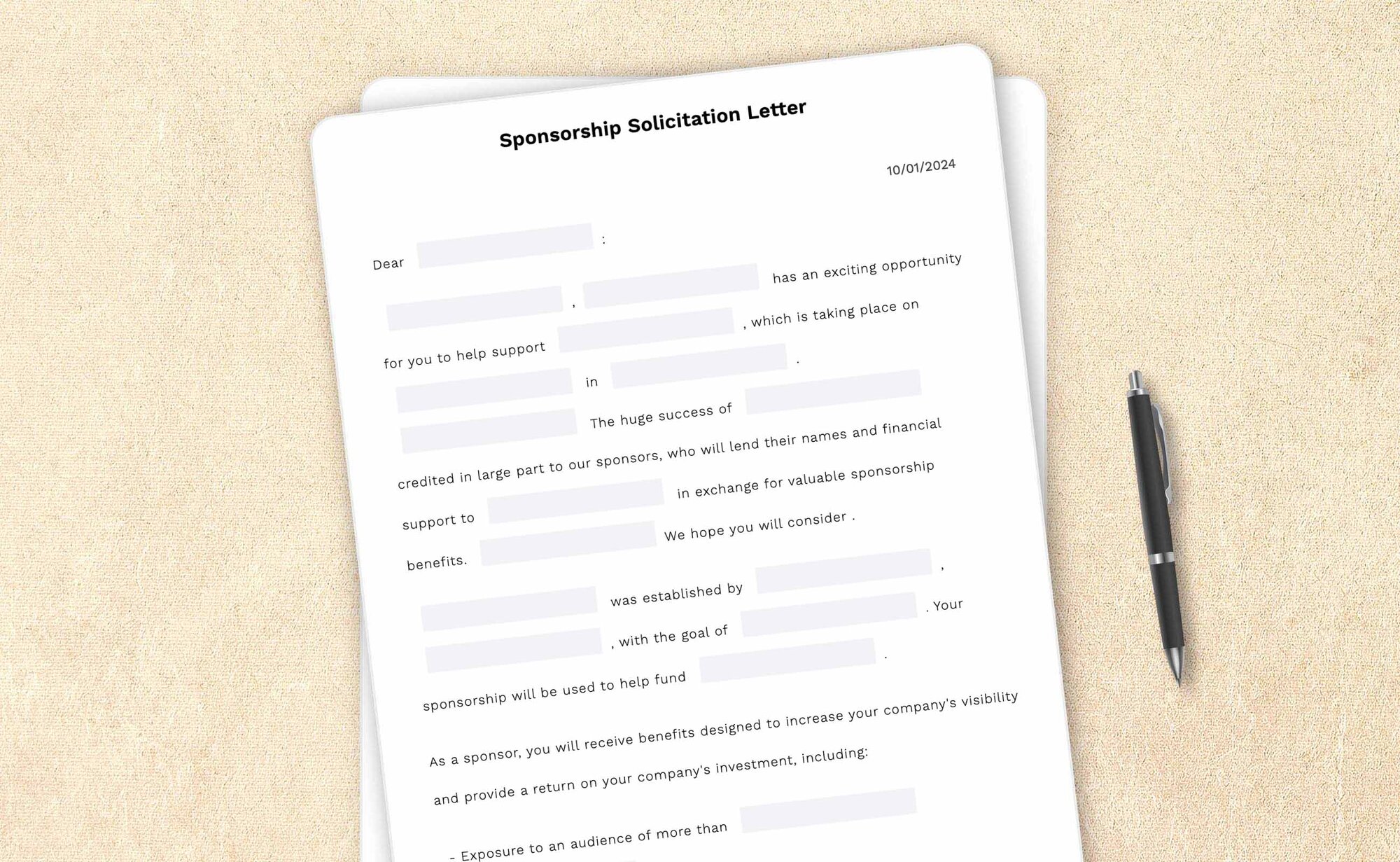Dear
As a sponsor, you will receive benefits designed to increase your company's visibility and provide a return on your company's investment, including:
- - Exposure to an audience of more than
. - - Name recognition in press releases and media coverage.
- Inclusion of your name and logo in all promotional materials. - Reserved premium table seating and complimentary parking. -
You can find additional information about sponsorship benefits
We appreciate your consideration.
| Sincerely, | |||||||||||||||||||||
___________________________________________ |
How-to guides, articles, and any other content appearing on this page are for informational purposes only, do not constitute legal advice, and are no substitute for the advice of an attorney.
Sponsorship solicitation letter: How-to guide
Sponsors provide a significant source of funding for many events. An effective letter to solicit sponsorship is essential to a successful event. Apart from the actual fundraising efforts, writing sponsorship letters requires knowing where to start or what to include.
This article helps you create a structured and personalized sponsorship letter.
What are the key aspects to consider in a sponsorship letter?

1. Researching about the potential sponsor(s)
Before writing a sponsorship letter, research the potential corporate sponsor(s), companies, or individuals you contact. Research can help you locate a corporate donor with a history of supporting interests similar to yours. The more targeted your approach is, the less time and money you’ll spend on your search.
2. Identifying the opportunities
To successfully secure corporate sponsorship for your event, it's crucial to first clearly understand the benefits sponsors will receive in return for such corporate donations. Identify all the opportunities you'll provide to the corporate sponsors and ensure you can deliver on everything you promise before drafting your sponsorship proposal.
3. Creating different sponsorship tiers
Create different sponsorship tiers that offer additional benefits with increasing donation amounts. By providing multiple sponsorship levels, sponsors can choose the option that best suits their budget, leading to increased participation. Depending on the benefits of each level, you may limit the number of sponsorships available for each tier.
4. Building potential sponsors' confidence
It's important to point out the successes of your organization and the event to the sponsors. Some background information can give potential sponsors confidence that the event is worth investing in. If you're organizing the event for the first time, focus on other events, experiences, or qualities of your organization that demonstrate your ability to make this event successful.
5. Integrating corporate social responsibility and corporate philanthropy strategically
Demonstrate how this sponsorship can reflect their commitment towards fulfilling their corporate social responsibility and how this opportunity would be most appropriate for them as it matches every aspect of their business.
Engaging in corporate philanthropy can provide businesses with tax benefits and incentives.
6. Drafting the letter
The standard elements to structure the solicitation letter are as follows:
a) Length of the sponsorship letter
Maintaining a length of one to two pages is effective in conveying the message when crafting a sponsorship solicitation letter.
b) Letterhead content
The name of the event, its location, and the name of the organizer and recipient.
c) The subject
Mention the subject of the event sponsorship letter as the event name with your event's title.
d) Address the recipient
It is advisable to address the recipient by name instead of a generic greeting like 'Dear Sir/Madam.' This personal touch shows that you value their time and attention, increasing the likelihood of your letter being read and considered.
e) Opening paragraph
- The name of the event, its location, and the name of the organizer and recipient go in the opening paragraph (in addition to the letterhead).
- The purpose of the letter is to solicit event sponsorship (including any specific sponsorship amount or level you seek). Mentioning this goal in the opening paragraph and at the end of the document strengthens your letter.
- Organizations with 501(c)(3) status should mention it in the opening paragraph to inform potential sponsors of tax-deductible amounts.
f) Second paragraph
- A brief description of your organization and the event.
- Mention the event details to attract relevant sponsors. Additionally, you may add anecdotes about the event to make it more appealing. For instance, if the event is a golf tournament, and a celebrity golfer participated last year, generating significant media attention, you may mention it in your letter.
- Illustrate the sponsorship as an opportunity to promote the brand to the target audience, highlight its key benefits, and provide additional sources of information in the third paragraph. Emphasize the unique aspects of your event and the sponsorship levels associated with them. By doing so, you can showcase the specific benefits the potential sponsors will receive, making the sponsorship more appealing and valuable to them.
- Outline how they can commit (maybe by filling out a form or a token amount of sponsorship) and close with a statement of appreciation for their consideration in sponsoring your event.
7. Proofreading
Proofread the letter carefully, and check for the spelling of recipients, the organization's name, your event name, or any other important element of the letter. Address the prospective sponsor's organization by name, ensuring all references are uniform and apply correctly to the letter's recipient.
8. Contact information
Provide accurate contact information, such as the key personnel's phone number or email address, so potential sponsors can contact you with any follow-up questions.
9. Call to action
At the end of the letter, provide a clear call to action, listing all the ways a potential sponsor can make a sponsorship commitment (e.g., by mail, fax, online). It'll guide potential sponsors on the next steps and make it easier for them to respond.
10. Including critical documents
When sending a sponsorship solicitation letter, it's a good idea to include some additional promotional materials. These can be:
- A flier that outlines the different sponsorship benefits and tiers (if applicable)
- A commitment form (so that they show interest and get started)
- A self-addressed return envelope
- A brochure or a one-page fact sheet about the event (or a past event)
- A list of past sponsors (if the event has happened before)
- A one-page fact sheet about your company or organization
- A copy of the 501(c)(3) letter if you're a charitable organization or nonprofit organization
11. Following up with the potential sponsors
After sending solicitation letters to potential sponsors, following up with them is a must. It would enable you to answer any questions and address the concerns preventing them from sponsoring your event.
How does a template help you draft your sponsorship solicitation letters?
A template simplifies the process of drafting your sponsorship solicitation letters by providing a structured framework that ensures consistency and professionalism. It helps you organize essential information—such as the purpose of the sponsorship, benefits for the sponsor, and the sponsoring event’s mission and objectives—into a cohesive and compelling message.
By using a template, you reduce the risk of overlooking critical details. With a template, you can maintain consistency in tone and style across multiple letters, saving time and effort while increasing the likelihood of securing sponsorships.
You can start creating your letter document by using LegalZoom’s sponsorship solicitation letter template, which is given right at the top of this page. Start drafting your document by answering the guided questionnaire, customizing it, if required, and filling it out. Once you have completed your letter document, you can easily download it in .pdf form.
Besides a sponsorship solicitation letter, you can also check out our various other professional templates of letters that can be used for your business.
Frequently asked questions
What's a sponsorship solicitation letter?

No matter what great cause you raise money for, you're a pro at throwing events people love. But even someone with your skills needs help sometimes—such as when it comes to finding funds. A sponsorship solicitation letter can successfully woo sponsors and secure the funding you need for an event.
What information is needed to complete a sponsorship request letter?
Here's the information you'll need to complete a sponsorship request letter:
- To whom you're sending the letter: Have their name and contact information ready
- Who's organizing the event: Have their name and contact information ready. (This is probably you or an organization you represent)
- When, where, and why about the event: Know the date, location, and who it's raising money for
- Sponsor perks: Explain what the sponsor gets out of giving
